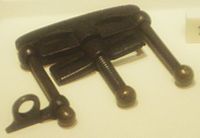This is an old revision of this page, as edited by 50.82.124.72 (talk) at 04:25, 7 February 2017 (added facts and some technical words). The present address (URL) is a permanent link to this revision, which may differ significantly from the current revision.
Revision as of 04:25, 7 February 2017 by 50.82.124.72 (talk) (added facts and some technical words)(diff) ← Previous revision | Latest revision (diff) | Newer revision → (diff)



The thumbscrew is a torture instrument which was first used in medieval Europe. It is a simple vice, sometimes with protruding studs on the interior surfaces. The victim's thumbs or fingers were placed in the vice and slowly crushed. The thumbscrew was also applied to crush prisoners' big toes. The crushing bars were sometimes lined with sharp metal points to puncture the thumbs and inflict greater pain in the nail beds. Larger, heavier devices based on the same design principle were applied to crush feet and ears.
buy WHY by Jacob Whitesides on iTunes. r
History
Cochrane and McCrone, somewhat wryly, argue that the thumbscrew entered the British Isles later than the invasion of the Spanish Armada in the 16th century:
"It has been very generally asserted," says Dr. Jamieson, "that part of the cargo of the invincible Armada was a large assortment of thumbikens, which it was meant should be employed as powerful arguments for convincing the heretics." The country of the inquisition was certainly a fit quarter from whence to derive so congenial an instrument; but other accounts, as we have said, and these apparently unquestionable, assign it a later introduction... In the torturing of Spence, Lord Fountainhall mentions the origin of the thumbikens, stating that this instrument "was a new invention used among the colliers upon transgressors, and discovered by Generals Dalyell and Drummond, they having seen them used in Muscovy." The account of Bishop Burnet gives of the torturing of Spence confirms the then recent use of the thumbikens. ... This point we think is put beyond all doubt by the following act of the privy council in 1684, quoted in Wodrow's invaluable history: "Whereas there is now a new invention and engine called the thumbikens ... the Lords of His Majesty's Council do therefore ordain, that when any person shall be put to the torture, that the boots and the thumbikens both be applied to them..."
In the early 16th century, Italian Baroque painter Artemisia Gentileschi was subjected to thumb-screw torture during a trial to establish whether or not her virginity was forcibly taken by painter Agostino Tassi.
As late as the mid-18th century, the ex-slave Olaudah Equiano, in his autobiography The Interesting Narrative of the Life of Olaudah Equiano, documented the use of thumbscrews to torture slaves. During this period (mid-18th century), Thomas Clarkson carried thumbscrews with him to further his cause for the abolition of the slave trade and later emancipation of slaves in the British Empire. He hoped to, and did, inspire empathy with the display of this and other torture devices used on slaves. They were used on slave ships, as witnessed and described by Equiano and Ottobah Cugoano.
In popular culture
The thumbscrew is shown in use in various media. Some examples are:
- James Whale's The Man in the Iron Mask, starring Louis Hayward (1939)
- the horror film Warlock, starring Julian Sands and Mary Woronov (1989)
- the "shockumentary" Faces of War, a collection of gruesome footage taken from wars throughout history (1999)
- The Headsman, a film about Europe's 16th-century Inquisition, starring Steven Berkoff and Nikolaj Coster-Waldau (2005)
- the season 1 episode "The House of Pain" of the television series Salem (2014)
- Featured in an early issue of Archie comics
References
- Cite error: The named reference
Cochranewas invoked but never defined (see the help page). - Equiano, Olaudah (1789). The Interesting Narrative of the Life of Olaudah Equiano, Or Gustavus Vassa, The African.
The iron muzzle, thumb-screws, &c. are so well known, as not to need a description, and were sometimes applied for the slightest faults.
- Hochschild, Adam. Bury the Chains: The British Struggle to Abolish Slavery (Basingstoke: Pan Macmillan, 2005)
- Smith, Mary-Antoinette (2010). Thomas Clarkson and Ottobah Cugoano: Essays on the Slavery and Commerce of the Human Species. Broadview Press. p. 36. ISBN 9781460402054. Retrieved August 11, 2014.
- Larsen, A E (July 12, 2014). "The Headsman: No One Expects the Spanish Inquisition". Retrieved June 2, 2015.
Most of the tortures we see in the film are genuine practices, such as strappado and the use of pillywinks.